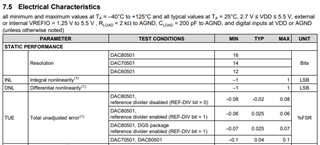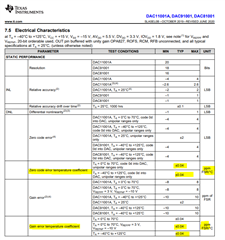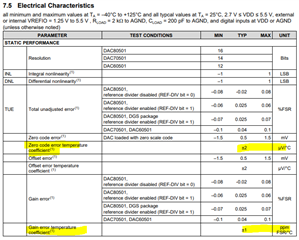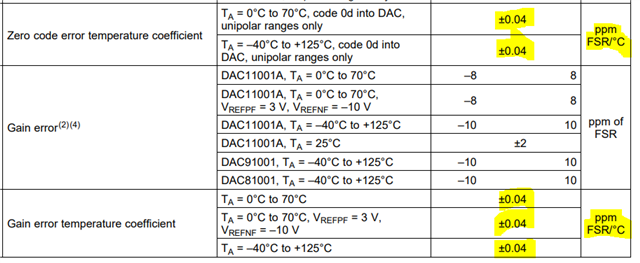Other Parts Discussed in Thread: DAC11001A
Hi Experts,
Good day.
Our customer is asking how to calculate the accuracy of DAC80501.
please advise.
Keep safe.
Regards,
Josel
This thread has been locked.
If you have a related question, please click the "Ask a related question" button in the top right corner. The newly created question will be automatically linked to this question.
Hi Josel,
Please review this TI Precision Labs video that discusses how to calculate the total unadjusted error (TUE) for a DAC: https://training.ti.com/ti-precision-labs-dacs-precision-dac-calibration?context=1139747-1140267-1140260-1140263-1140264.
This is a conservative way to combine the DAC errors listed in the datasheet. Also keep in mind reference error will also factor into this. If you are using an external reference you will need to incorporate the error of that reference.
The datasheet does give a measured TUE value under the listed conditions:

There are also a few TUE plots in the typical characteristics section.
Best,
Katlynne Jones
Hi Katlynne,
Good day.
May I know how to get the Zero code drift and Gain Error drift?
Error Calculation for Unbuffered R2R DAC – Example Using DAC11001A (Rev. A)
Regards,
Josel
Hi Josel,
That would be the Zero code error temperature coefficient and Gain error temperature coefficient. Here is a screenshot from the DAC11001A datasheet. You can see that the temperature drift is given in ppm FSR/C:

The DAC80501 gives the zero code error drift in uV/C and the gain error drift in ppm FSR/C. Make sure you translate everything into the same units before summing the errors.

Best,
Katlynne Jones
Hi Katynne,
Good day.
The concern is how we translate/convert the ppm %FSR/C to LSB.
I am searching but it seems that I can't find a reliable formula for that.
Could you please help me if you have an idea?
Thank you.
Regards,
Josel
Hi Josel,
PPM stands for parts per million. 1 ppm = 0.0001% (2ppm = 0.0002%). 1 ppm of a 5V FSR would be 5uV (5/10^6 or 5*0.0001%).
1 LSB = FSR/(2^n) where n is the DAC resolution.
So ppm to LSB would be: (0.0001%)*(2^n). 1ppm of a 16-bit DAC would be (0.0001%)*(2^16) = 0.0655 LSB.
Best,
Katlynne
Hi Katynne,
I'm sorry. My question is wrong.
This way. Please help convert the ±0.04 ppm FSR/°C to 40 ppm.
From the datasheet temperature coefficient of ±0.04 ppm FSR/°C
We will get 40 ppm
You said that "Zero code drift" and "Gain error drift" is coming from the "Zero code error temperature coefficient" and "Gain error temperature coefficient" respectively.
Regards,
Josel
Hi Josel,
Typically you just multiply the drift by the temperature range of interest as shown in this portion of the article:

But I am not able to get the same value as shown in the table when I use that equation. I need to check with the author of this article to see what values they used to calculate the 40ppm given in the table. I'll let you know when I hear back from them.
Best,
Katlynne Jones
Hi Josel,
Here is their explanation:
Gain error drift spec is ±0.04ppm FSR/degC
FSR = 10V, so drift = ±0.4 ppm/C
Operating temperature range = -40 to +125 C
Drift Error in ppm = ±0.4 ppm/C x Max operating temperature range , where
Max Operating temp range = Max { abs [T high - 25 ] , abs [ Tlow – 25 ] }, assuming calibration is performed only at 25 C
So Max operating temp range = Max [ abs(125-25) , abs (-40-25) ] = Max [ 100, 65] = 100 C
Gain error drift in ppm = ±0.4 x 100 = 40 ppm
Best,
Katlynne Jones